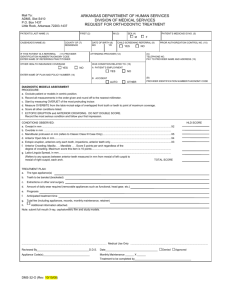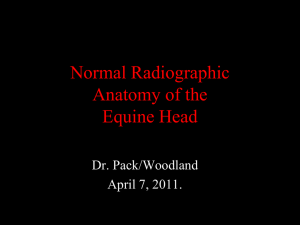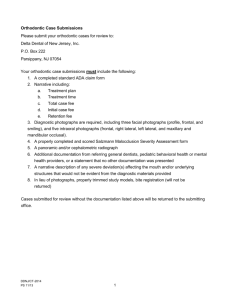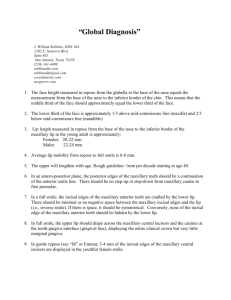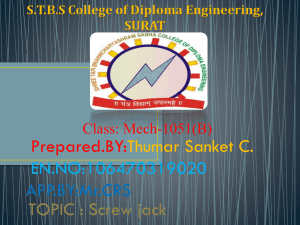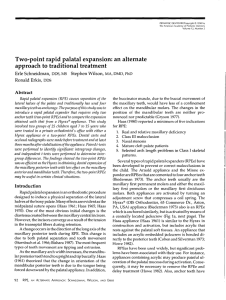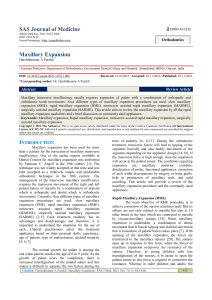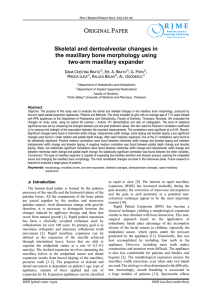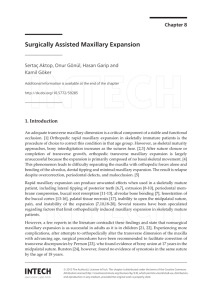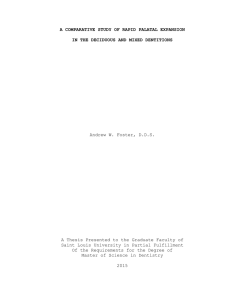Rapid_palatal_expander_wiki_no_photo
advertisement
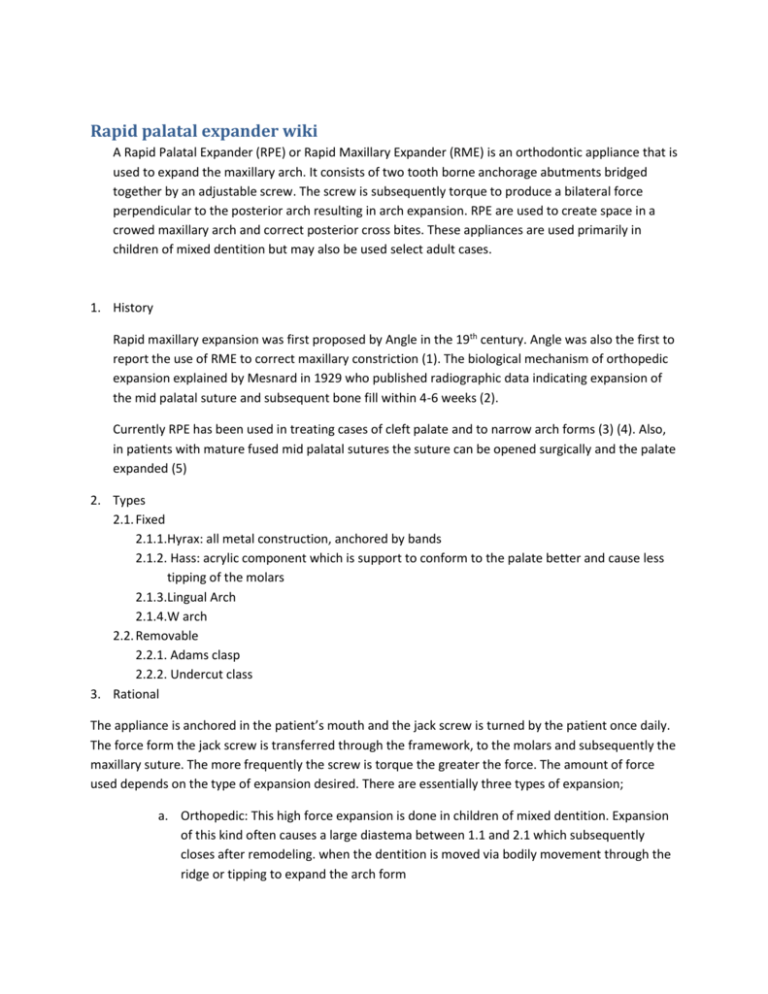
Rapid palatal expander wiki A Rapid Palatal Expander (RPE) or Rapid Maxillary Expander (RME) is an orthodontic appliance that is used to expand the maxillary arch. It consists of two tooth borne anchorage abutments bridged together by an adjustable screw. The screw is subsequently torque to produce a bilateral force perpendicular to the posterior arch resulting in arch expansion. RPE are used to create space in a crowed maxillary arch and correct posterior cross bites. These appliances are used primarily in children of mixed dentition but may also be used select adult cases. 1. History Rapid maxillary expansion was first proposed by Angle in the 19th century. Angle was also the first to report the use of RME to correct maxillary constriction (1). The biological mechanism of orthopedic expansion explained by Mesnard in 1929 who published radiographic data indicating expansion of the mid palatal suture and subsequent bone fill within 4-6 weeks (2). Currently RPE has been used in treating cases of cleft palate and to narrow arch forms (3) (4). Also, in patients with mature fused mid palatal sutures the suture can be opened surgically and the palate expanded (5) 2. Types 2.1. Fixed 2.1.1.Hyrax: all metal construction, anchored by bands 2.1.2. Hass: acrylic component which is support to conform to the palate better and cause less tipping of the molars 2.1.3.Lingual Arch 2.1.4.W arch 2.2. Removable 2.2.1. Adams clasp 2.2.2. Undercut class 3. Rational The appliance is anchored in the patient’s mouth and the jack screw is turned by the patient once daily. The force form the jack screw is transferred through the framework, to the molars and subsequently the maxillary suture. The more frequently the screw is torque the greater the force. The amount of force used depends on the type of expansion desired. There are essentially three types of expansion; a. Orthopedic: This high force expansion is done in children of mixed dentition. Expansion of this kind often causes a large diastema between 1.1 and 2.1 which subsequently closes after remodeling. when the dentition is moved via bodily movement through the ridge or tipping to expand the arch form b. Surgical expansion: Very similar force to orthopedic expansion except the suture is surgically opend. Is used in adult patients. c. Orthodontic expansion: This low force expansion can be performed in both children and adults and results in tipping or bodily movement of the dentition through the alveolar bone. This does not involve expansion of the maxillary arch. d. Passive: 4. Indication 4.1. Unilateral and bilateral crossbites 4.2. Dental crowding 4.3. Maxillary constriction 4.4. Mixed dentition 4.5. 8-13 years girls 8-15 males 5. Contraindications 5.1. Open bites: RPE tend to open the bite 5.2. High mandibular plane angle 5.3. Orthopedic adult patients ie slow maxillary expander is more frequently used 5.4. Spacing 6. Clinical procedure for common fixed Hyrax RPE (6) 6.1. Preatreatment workup and diagnosis 6.2. Separating elastics Place separating elastics mesial of the upper first molar to create enough space for placement of orthodontic bands. 6.3. Patient instructions and expectations The procedure takes about 10min. The next visit should be scheduled in 3-5 days. For discomfort the child can be administered acetaminophen or ibuprofen. 6.4. Band fitting Fitting of orthodontic bands on the anchor teeth (first molars) 6.5. Impression After band fitting take an alginate impression with the bands in place using a stock tray then sanitize the impression. 6.6. Band removal and placement in impression The bands are removed and placed in the impression. 6.7. Lab prescription The prescription form must be filled and sent along with the impression to the lab. 6.8. Replacement of separating elastics 6.9. Try-in Place the RPE in the patient’s mouth and seat the bands 6.10. Work the jack screw Perform two turns in one direction then two in the other to loosen the jackscrew extra orally. This will make it easier to activate the appliance intraoral. 6.11. Pumice teeth Mix pumice and water to paste like consistency and apply with a rotating brush around the surfaces of the molars and any rest areas. 6.12. Etch teeth 37% orthophosphoric acid is placed for 15s. Cement bands to teeth Cementation of the RPE bands with glass ionomer banding cement. Metal rests should be covered with 0.5mm of composite. 6.13. Pt instructions Explain to the child and parents on the number of turns, recall appointments, oral hygiene and diet. Tell them there will be a space between the two from teeth and that this is normal. 6.14. Activation Perform one screw activation every day If one day is missed do not turn twice on the following day Must not play with the wire Teeth should be brushed and flossed in the usual manner. As well rinse the mouth after each meal Should expect 8mm space between front teeth that will close 6.15. Activation phase with follow up It is important to turn the screw following the prescription schedule (1 turn every day for 30 days). After the patient and parent are instructed how to activate the screw, three ¼ turns are made at this visit at 5 minute intervals. There after the patient makes one ¼ turn per day The patient is seen again at the end of one week to check the progress. Activation is complete at 30 days. 6.16. Retention phase Appliance is left in for 3-6 months after the last activation for bone to fill in. It is best to ligate the screw in place after proper expansion is achieved by using composite or via metal ligature Radiograph the patient before removing the appliance to be sure the suture has filled in with bone. 6.17. Removal The appliance can be removed after the retention phase is accomplished 7. References Bibliography 1. Treatment of irregularities of the perminant or adult teeth. Angell, EC. 1860, Dent Cosmos. 2. Immediate separation of the maxillae as a treatment for nasal impermeability. Mesnard, L. 1929, Dent Rec, pp. 49;371-372. 3. Rapid maxillary expansion: Review of literature . Al-Battikki, R. 2001, Saudi Dental Journal, pp. Vol. 13, No. 3,. 4. Some effects of rapid maxillary - Expansion in cleft lip and palate patients. Isaacson, RJ. 1964, Angle Orthod, pp. 143-154. 5. Surgically-Assisted Rapid Palatal Expansion for Management of Transverse Maxillary Deficiency. Silverstein, K and Quinn, P.D. 1997, J Oral Maxillofac Surg, pp. 55:725-727. 6. Midpalatal suture opening during functional cross bite correction. Harberson, VA. 310, s.l. : Am. J. Orthod, 1978, Vol. 74.

